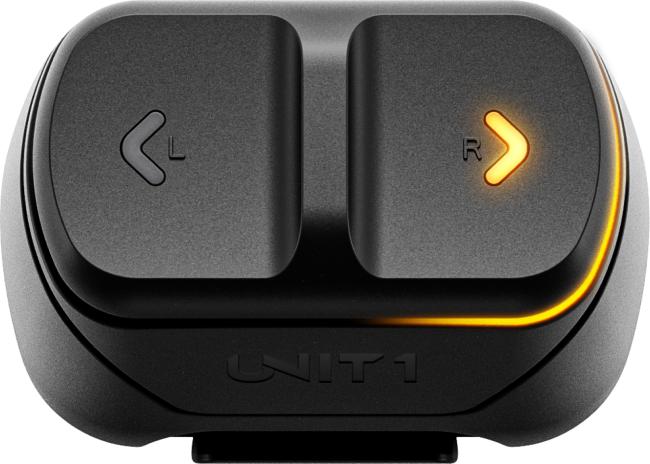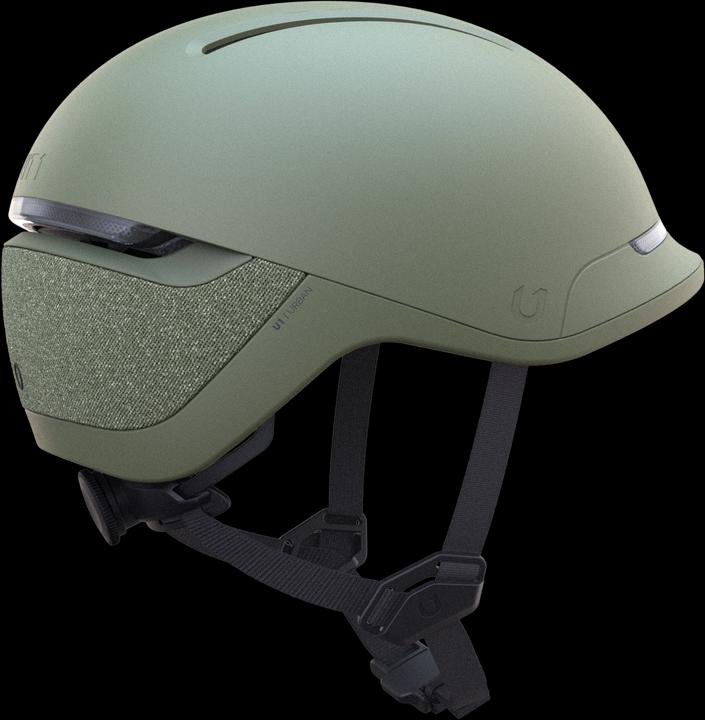

Light helmet "Faro" from Unit1: The automotiveization of the bike world is advancing
The luminous "Faro" from Unit1 is a statement like luxury SUV in the city. Chic design and full equipment make it an eye-catcher. I'm impressed, but still wouldn't afford it.
What the Porsche Cayenne is on the road, the "Faro" is on the head: too expensive, overweight and special equipment costs extra. In the case of Unit1's helmet, this applies to the remote control that controls the turn signals and brake lights. But it's a helmet that will make many people think, at least secretly, that it's cool. I would also like to have. At least, the designers report that in a blind test with pictures of various top models from well-known manufacturers, their "Faro" was chosen as the most stylish shell by more than half of the participants. It's quite possible that I would have chosen it, too. Visually, it appeals to me and I got myself a test model in the beautiful shade Juniper (juniper).

As soon as the box is open, I have to say: it's true. It is not only beautiful on the screen, but also looks outstanding in real life. And it feels that way. The fabric-covered back, which is the same color as the case, is particularly noteworthy. It spontaneously reminds me of a speaker cover. And indeed, several speakers were disassembled in the design process in search of the right material. The goal of the search was an elegant way to hide the LEDs behind it.
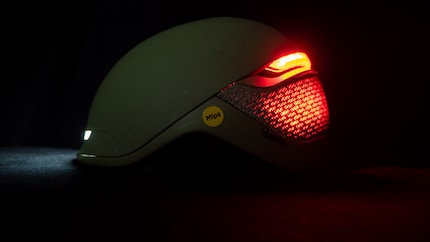
The "Faro" not only has a (always visible) bright rear light. Behind the weatherproof fabric, 46 additional LEDs are hidden at once, which are thus less glaring, but are intended to be effective at close range. They not only shine red as tail and brake lights, but also yellow when flashing and green when they indicate the battery status. A 90-degree angled USB-C charging cable is also included in the box, and that's it. One impression is particularly noticeable: The "Faro" is heavy. 612 grams in size M. That looks valuable, feels borderline for me at first, and is still okay after some time to get used to it on the head.
Safety aspects
Like many other models, the usefulness of the "Faro" is not limited to protecting the head when falling. It complies, of course, with the mandatory European standard EN1078 and it is available with MIPS. The system that reduces the rotational forces in the event of an impact by means of a movable inner shell. Because in safety matters is now thought more comprehensive, it should also help to avoid accidents through the lighting.
The "Faro" can also trigger an SOS alarm. In the event of a severe impact, emergency contacts are informed and the location is sent, unless I confirm via the app within a predefined period of time that it was a false alarm and everything is okay. In return, it sends me a push message. Under real-life conditions, I don't want to try this out. Instead, I throw the helmet on a fatboy a few times with a swing and the alarm triggers at some point.

The helmet deliberately leaves a few safety gaps open: The beautiful skater helmet look is not disturbed by an insect screen in the ventilation. The air supply can also not be regulated or closed. In the rain you have no choice and get wet, in the cold it pulls on the head. But you can adjust the light in a thousand and one ways.
Light
Maybe the designers exaggerated a little bit with the light. At least that's my first thought when the entire back of the helmet flashes in bright red. On the other hand, they've elegantly integrated the technology and give me the option to use it according to my preferences. From the brightness of the front and rear lights to their flashing, strobing and illuminating behavior to the use of the hidden lights, I can individualize everything. Actually, the "normal" light bar would also already make a good taillight, but of course I do not do without the highlight of the helmet. In addition, I will activate the ambient light and weather detection, which reacts according to the conditions. In bright daylight, for example, it switches to highly visible flash.
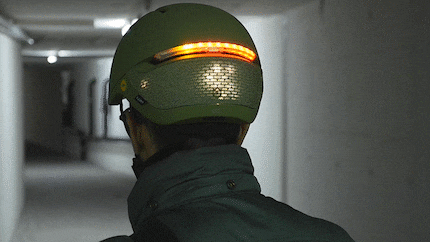
While playing with the settings options in the app, I quickly realize that it comes at a price: The estimated battery life drops rapidly the more features I activate. Bright continuous light in the front and back, the hidden lights on "flash", weather and drop detection on - and just ten hours become a good two hours of expected use until the battery runs out of juice. At this point, it is still charged to about 90 percent, the rest was used up during setup and initial testing. And I haven't even connected the remote yet.
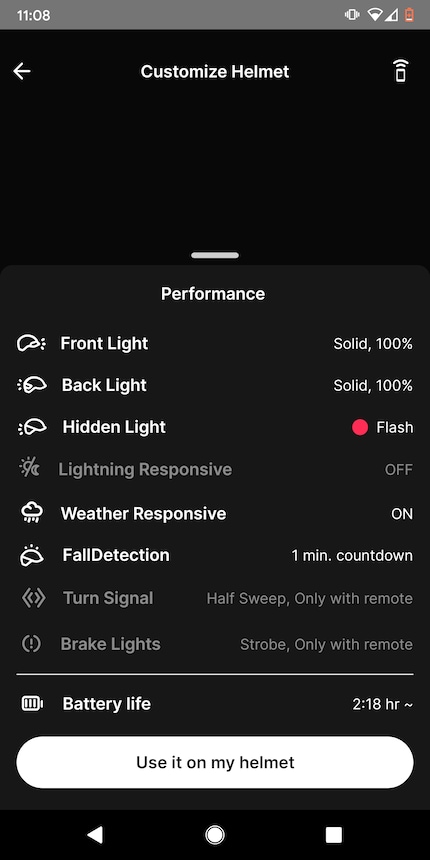
Remote control
To use flashing and the brake light, I need the remote. These two functions make the hidden lights really useful, as they function as both a directional indicator and a highly visible warning light. Despite the hefty price tag for the helmet, the remote is not included and must be purchased separately.
The manufacturer justifies this by saying that many customers are not interested in these functions and want to save them additional costs. In my opinion, if the "Faro" is to be used, then it should definitely come with a remote control. It is easy to install, simple to operate and can be removed with a twist to charge the battery. Its integrated acceleration sensor controls the brake light. If it registers a strong deceleration, the LEDs on the back of the helmet flicker red.
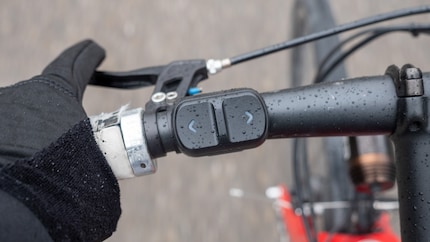
If I activate the turn signal, the direction arrow on the remote flashes. This is important, because unlike the Lumos Ultra or the Livall "BH51M Neo", there is no audible companion signal. The "Faro" is mute, although it looks like a speaker. I think this is fine. The flasher can also be configured to turn itself off after a few repetitions, and when flashing continuously, the light on the remote catches your eye. That way I don't forget to turn it off again.
App
There is no way around the app(iOS/Android) when setting it up. Here I can define what happens to the lights and, if I want, become part of a community. Track rides, win badges, reach goals and tackle challenges. For example, burn the calories of a Big Mac. I don't want all that, but it would be possible. Fortunately, it's also possible to get out of the way of all that and focus on setup. This area is clear and works reliably for me.
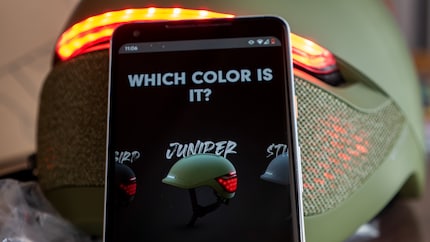
Battery and life
A non-removable lithium-ion battery with a capacity of 1850 MAh is installed in the helmet. It charges in three hours and is said to last over 500 charge cycles. If I charge the helmet twice a week, there should be five years of festive lighting before eternal darkness reigns on the "Faro". That's the lifespan that manufacturers usually give their helmets before recommending replacement. However, a K-Tipp test shows that a well-maintained helmet can protect much longer. And, quite honestly, if I were to afford the "Faro," five light years would be too few for me. I'd want to wear it longer and use all the features. Unit1, on the other hand, finds it sustainable that the life expectancies of helmet and battery are in harmony.
Everyday experiences
As long as everything works, I am convinced of the additional benefit of lighting on the head. And the "Faro" leaves nothing to be desired. The large-area brake light is hard to miss even for inattentive fellow traffic behind me. The lateral visibility is also given and in front everything fits: The white front light shows by flowing flashing, in which direction it should continue. Thanks to the many configuration options, I have it in my own hands how conspicuously illuminated I want to be on the road.
But I particularly like a few details on the helmet that other manufacturers pay little attention to. In the Lumos Ultra, for example, I was somewhat disappointed by the chin strap, which was left out of the design process and is equipped with 08/15 parts. I hate fiddly straps and fasteners that need constant readjustment.
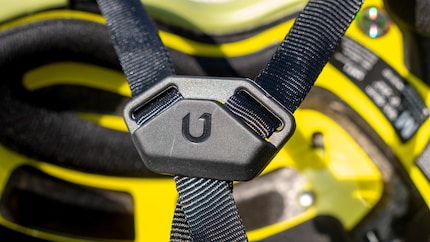
On the "Faro", the straps have a wide guide that makes it easier to adjust on the ear and holds relatively well. Also, the magnetic Fidlock closure on the chin is better than a simple plastic buckle. I have to hand it to Unit1: Their overall package is right, they didn't skimp on anything according to the price. Not even on energy consumption. In my test run with setup in the app, full lighting and all features, the "Faro" actually just turns off after a little more than two and a half hours.
Conclusion
The helmet is great designed and packed with features. Not much more is possible. Maybe a speaker in the neck so I can use it as a boombox in the park. All the lights, alarms and fancy details come at a price. But if you put a few thousand on the table for a new e-bike, you might also pick up the fanciest helmet for a few extra hundred. And the few tens for the remote control? It's a gift! That's how it used to be with aluminum rims and the sports package in a new car. Today, designer pieces like the "Faro" are also a sign of increased appreciation for bikes.
I have nothing against that. But against another parallel to the car world. If I really step on the gas and use all the features, the energy hunger is too great for me. And if I don't use them, I'm also well served with another model. Rationally speaking, my verdict is therefore more sober. I can get a good helmet with comparable functions for much less. I'll stick with the Lumos Ultra, which is lighter and lasts longer - even if I'm reluctant to give up the beautiful "Faro".
Simple writer and dad of two who likes to be on the move, wading through everyday family life. Juggling several balls, I'll occasionally drop one. It could be a ball, or a remark. Or both.

